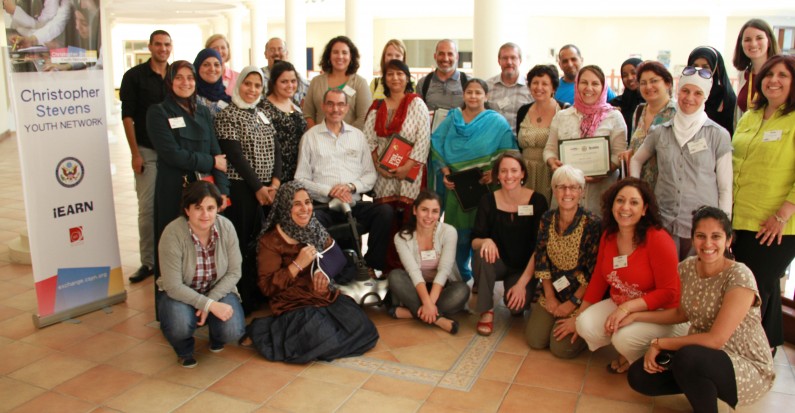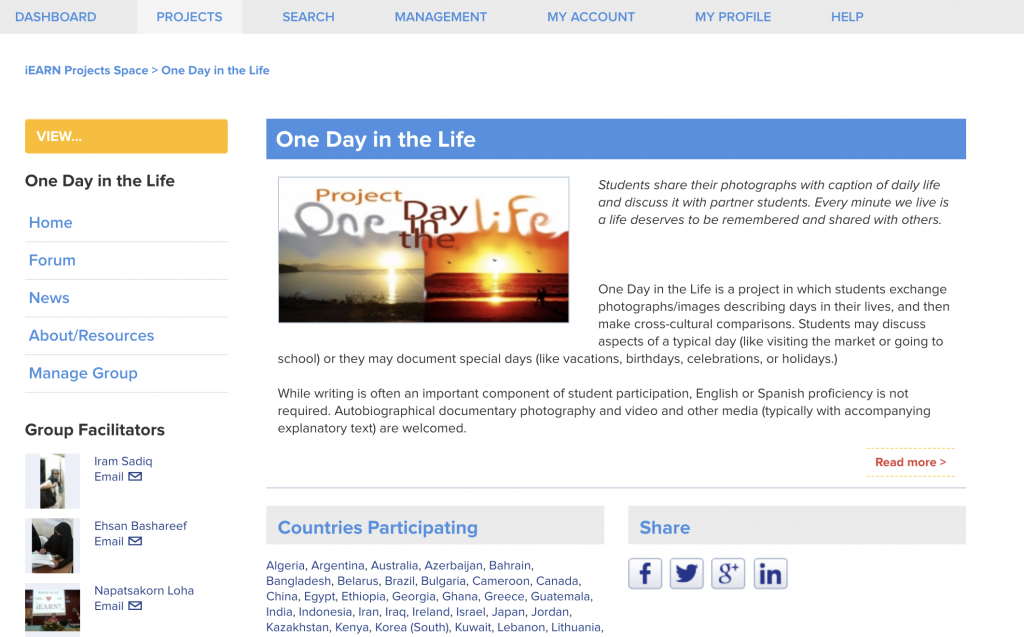Introduction To iEARN & Global Collaborative Projects
This resource is designed to guide teachers through the steps of planning and conducting an online, collaborative project with classrooms around the world. You will be introduced to global, project-based learning and collaboration through the International Education and Resource Network (iEARN).
EXPANDING OPPORTUNITY THROUGH VIRTUAL EXCHANGE AND GLOBAL PROJECT-BASED LEARNING
Students are keenly aware that it is in their best interest to understand global issues, engage with their peers worldwide, and gain the sills needed to find employment in today’s global economy. Yet, while opportunities for international exchange are expanding rapidly in many countries around the world, only a small fraction of students currently have access to some kind of international experience.
Using the Internet and web 2.0 tools to provide connectivity, virtual exchange programs increase the number and diversity of students worldwide who have a profound cross-cultural experience as a part of their education. The global reach of the Internet has shown us that we can build local-to-global multicultural understanding of human experiences across content areas including social studies, science, math, languages, history, and arts.
“I hope I can call myself a graduate of iEARN. It has truly impacted my life. I joined in high school. iEARN changed my perspective towards things – when there was a situation, I looked at it in terms of what I could do to help and not what I could do to gain. My participation in iEARN enabled me to learn how to use computers and enable me to get my first job when I was out of school.
~Jubilee, iEARN Student Alumnus, Uganda
GLOBAL PROJECT-BASED LEARNING WITH iEARN
iEARN is a global non-profit network that facilitates cross-cultural interaction, global classroom projects, and new learning opportunities online. Through iEARN, students worldwide make meaningful contributions to the health and welfare of the planet by exploring real world issues and working collaboratively with local and global peers to find solutions.
Established in 1988 as a pilot project between schools in New York and Moscow, iEARN has grown into an international network of tens of thousands of schools in more than 140 countries, each organizing national programs, but operating with the same vision and purpose of supporting young people to make a difference in the world. The iEARN global network is now active in more than 30,000 schools and youth organizations and more than 2,000,000 students are engaged in collaborative project work.
iEARN Projects Align with the UN Sustainable Development Goals (SDGs)
iEARN projects provide opportunities for students to research and collaborate with peers globally on themes that are important for 21st century classrooms such as health, environment, social entrepreneurship, empowering girls and young women, food security, civic education, conflict resolution and peace education, and literacy and education.
“iEARN is providing us a window through which we can see not only others but be seen by others as well.”
~Lockias Chitanana, iEARN Teacher, Zimbabwe
Curriculum-based projects
 An iEARN project is a collaborative academic endeavor between two or more groups of students and educators in different parts of the world. iEARN projects take on many different forms, but most are rooted in the pedagogy of project-based learning. Most projects are process-oriented, but also result in some kind of end “product” that is shared between the participants. The projects are designed and facilitated by teachers and students in the iEARN network. All projects within iEARN can be adapted to fit participants particular curriculum and classroom needs and schedules. As education standards vary by state, country, and subject, there is no single model for project involvement.
An iEARN project is a collaborative academic endeavor between two or more groups of students and educators in different parts of the world. iEARN projects take on many different forms, but most are rooted in the pedagogy of project-based learning. Most projects are process-oriented, but also result in some kind of end “product” that is shared between the participants. The projects are designed and facilitated by teachers and students in the iEARN network. All projects within iEARN can be adapted to fit participants particular curriculum and classroom needs and schedules. As education standards vary by state, country, and subject, there is no single model for project involvement.
In addition to connecting classroom education with local issues and meeting specific curriculum needs, every iEARN project must answer the question, “How will this project improve the quality of life on the planet?” This vision and purpose is the glue that holds iEARN together, enabling participants to become global citizens who make a difference by collaborating with their peers around the world.
“…today we also have digital bridges to connect different cultures… These students are working together online, learning from each other about their cultures and history, and they’re forging lasting relationships.”
~ U.S. Secretary of State John Kerry
Collaboration Centre
The curriculum-based projects are housed in iEARN’s Collaboration Centre, an online platform that enables groups to make connections, participate in forum discussions, share media, and collaborate towards their final project.
The iEARN Collaboration Centre enables youth to learn with, rather than simply about the world, through interactive curriculum-based groups in which students are creating, researching, sharing opinions, and becoming global citizens.
>> Top
“The world of tomorrow, or I would say of today, is no more geographical boundaries… we really need to know each other, we really need to be tolerant of each other, really need to be understanding of each other’s practices, respecting the differences. I see iEARN as playing a pivotal role in making this happen.
~ Farah Kamal, iEARN-Pakistan Country Coordinator
HOW TO USE THIS GUIDE
This resource is designed to guide educators through the steps of planning and conducting an online, collaborative project with classrooms around the world. The guide includes nine modules to help you plan and develop a project experience for students. Each module includes reflection activities to develop your project plan and additional resources for you to further explore a topic.
You can follow the modules and activities in order to develop your project plan or reference specific sections to build on an existing plan. The modules will guide you through:
-
-
- Developing a project idea and selecting an iEARN project;
- Making a project plan;
- Building relationships with educators and students through digital dialogue;
- Using technology tools in your global project;
- Engaging the community in your classroom project;
- Presenting, exhibiting, and assessing student learning in global projects.
-
“If I had to define very shortly how iEARN contributed to my career, I would say that participating in iEARN activities helped me to develop the skills that I master today and which are essential to my work.”
~ Jurga, iEARN Student Alumnus, Lithuania
Icons used in this Guide
There are several icons used on the right side bar and sometimes within the content. Explanations of these icons are given below:
Project Snapshot |
|
Tips |
|
Tools |
|
Resources |
|
Reflection |
|
Key Questions |
>> Top

